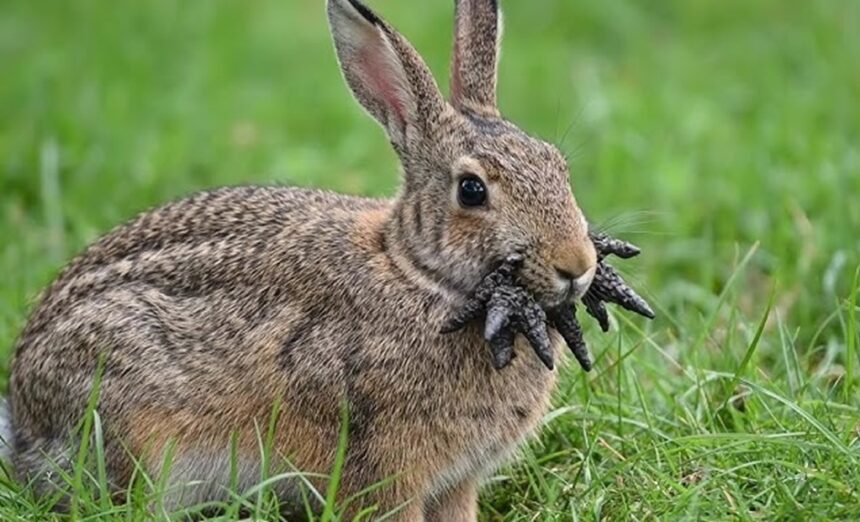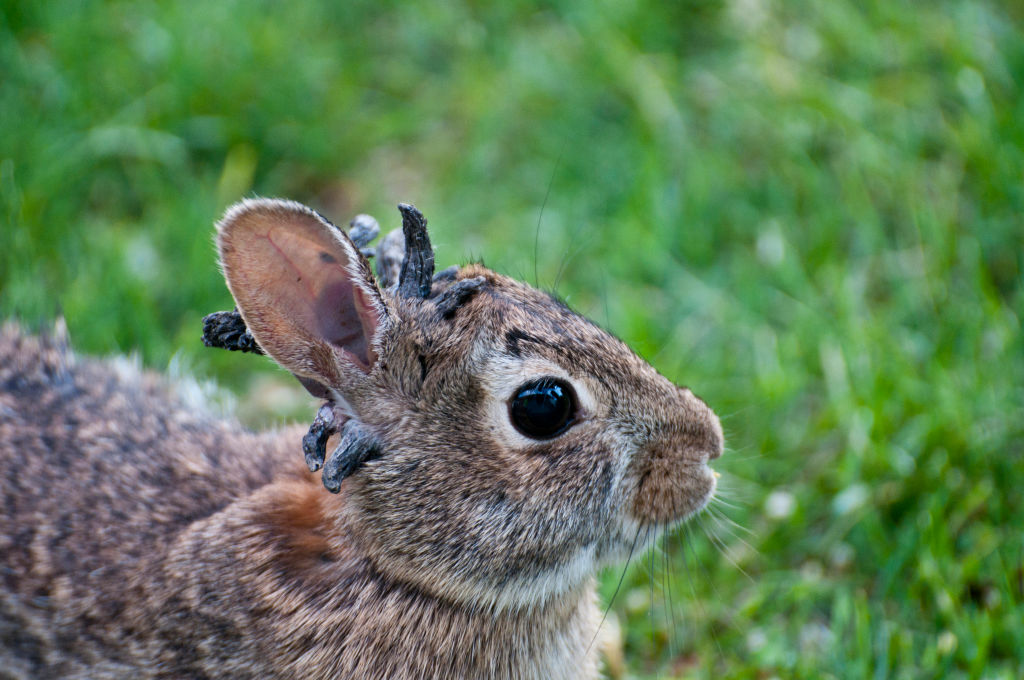COLORADO – Over the last week, social media worldwide has been flooded with posts showing rabbits sporting odd, horn-like growths on their heads. Nicknamed “Frankenstein rabbits” by shocked viewers, these animals have stirred up both fascination and unease online, shifting what started as a local wildlife story into a global trending topic.
Reports from scientific communities and the public have been mixed with online speculation, prompting wildlife experts to remind people not to approach these infected rabbits. The phrase “Frankenstein rabbits” took hold quickly on platforms like X, where users circulated pictures of rabbits bearing dark, spike-like outgrowths. Many likened the sightings to scenes from horror films.
Posts by users such as @ClownWorld on August 13 described the animals as unnatural and unsettling, racking up thousands of reactions. Another popular contributor, @MisterIneffable, expressed sympathy for the rabbits but repeated warnings about keeping a safe distance.
The hashtag #FrankensteinRabbits started trending outside the US, drawing attention from people as far away as Europe, Asia and Australia, with users sharing everything from memes to personal theories. The term draws on classic horror, referencing Mary Shelley’s “Frankenstein”, and fits the rabbits’ haunting appearance.
Headlines like “Warning as ‘Frankenstein rabbits with tentacles sprouting from their heads invade parts of the US” (Daily Mail) and “Frankenstein rabbits spreading in the US due to rare virus spark frenzy” (Bored Panda) have sent online discussions into overdrive. Reactions have swung from fearful interest to genuine worry.
What Causes These Disturbing Growths?
These unusual growths are caused by the Shope papillomavirus, not a laboratory accident or experiment gone wrong. This virus, first identified by Richard Shope in the 1930s, affects rabbits and hares. It triggers the growth of tough, horn-like tumours (papillomas) on their skin.
The outgrowths can get surprisingly large and are usually dark, due to their keratin makeup. In some cases, the tumours can make it hard for rabbits to eat, move or see, causing significant distress or even death.
Dr Emily Carter, a wildlife vet from Colorado State University, explains that mosquitoes and ticks are mainly responsible for spreading the Shope papillomavirus between animals. “The virus attacks skin cells, leading to these horn-like growths,” Carter told CNN.
“While this isn’t a new disease, we’re seeing more cases in places like Colorado and the Midwest, possibly because warmer weather means more biting insects.”
The virus is limited to rabbits and doesn’t infect humans or other animals, but experts advise people not to pick up affected animals.
“The growths can become infected themselves, or help spread the virus if people handle the rabbits and then touch others,” Dr Michael Nguyen from the U.S. Fish and Wildlife Service told the media.
Posts like @OwenGregorian’s on August 13 have helped spread the message: “Do NOT touch them,” they advise, warning of further spread.
A Local Problem Draws the World’s Eye
Most reports of “Frankenstein rabbits” so far have come out of states like Colorado, where wild rabbit populations thrive in towns and countryside. Locals have reported far more sightings this year, sharing photos from back gardens, parks and mountain trails.
Images of rabbits with shockingly large spikes have gone viral on X, TikTok and Instagram, keeping the topic in public view.
But with global attention has come confusion. Some internet users suggest the rabbits are the result of dangerous scientific tests or pollution, despite research tying the growths to Shope papillomavirus.
One widely shared TikTok video, viewed over a million times, wrongly blamed radiation for the outbreak, drawing swift corrections from wildlife specialists. Meme creators, meanwhile, have leaned into the appearance, linking the images to famous horror films for laughs.
The situation has triggered arguments about how best to manage the rabbits. On X, some suggest more support for wildlife tracking, while others call for affected animals to be culled. Animal welfare groups push back, arguing that solutions should be humane.
“These rabbits are suffering. We should focus on understanding the virus and helping them, not blaming them,” says Sarah Mitchell from the Humane Society.
Media Coverage Fans’ Concerns
Mainstream media has played a big part in driving attention to this issue. Headlines like the Daily Mail’s “Warning as ‘Frankenstein’ rabbits with tentacles sprouting from their heads invade parts of the US” and Bored Panda’s “‘Frankenstein’ rabbits spreading in the US due to rare virus spark frenzy” describe the animals as “grotesque” and “horned”, blending fact with eye-catching language.
CNN has learned that the Shope papillomavirus is not a new risk. It’s become more visible because of how striking the rabbits look and how quickly images travel online. Wildlife agencies in Colorado note a small rise in cases over previous years, but stress that this is not an outbreak on a massive scale.
“We’re seeing clusters in some areas, but it’s not a disaster,” says Dr Nguyen. “Social media has blown the scale of the problem far out of proportion.”
The rising number of “Frankenstein rabbits” highlights bigger questions about wildlife health, climate, and the spread of information online. Warmer seasons and more insects may be helping the virus reach new regions.
At the same time, the speed of social media has transformed a local conservation issue into something the whole world is talking about.
Experts suggest that people stay calm and learn about the real causes. “This is a perfect example of nature coming together with technology,” says Dr Carter. “The virus is real, but the sense of crisis is partly down to viral images and rumours.
Protecting rabbits and sharing correct information should be the priority, not fanning panic.”
The bizarre appearance of these rabbits has become a symbol of nature’s surprises and how quickly the unknown can generate headlines and worry. Social media users are reminded not to touch wild rabbits showing signs of illness and to report sightings to local wildlife officials.
The topic continues to draw both serious concern and humour online, proving that even an animal with odd growths can become a viral story.
People who spot a rabbit with unusual growths should contact local wildlife services for advice. For details on the Shope papillomavirus, visit the U.S. Fish and Wildlife Service website.















